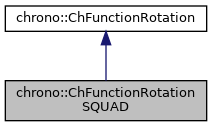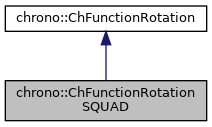Description
A rotation function q=f(s) that interpolates n rotations using a SQUAD spherical quadrangle interpolation between quaternions.
Differently from the ChFunctionRotationBSpline of order 3, this cubic interpolation really passes through the control points. In the original single-span SQUAD algorithm, 4 quaternions are used: the interpolation passes exactly in 1st and 4th, whereas 2nd and 3rd are 'magnetic' as ctrl points in splines; in our implementation the 2nd and 3rd are computed automatically given the sequence of the many SQUAD spans, per each span, enforcing continuity inter span.
#include <ChFunctionRotationSQUAD.h>


Public Member Functions | |
| ChFunctionRotationSQUAD () | |
| Constructor. By default constructs a linear SLERP between two identical null rotations. | |
| ChFunctionRotationSQUAD (const std::vector< ChQuaternion<>> &mrotations, ChVectorDynamic<> *mknots=0) | |
| Constructor from a given array of control points; each control point is a rotation to interpolate. More... | |
| ChFunctionRotationSQUAD (const ChFunctionRotationSQUAD &other) | |
| virtual ChFunctionRotationSQUAD * | Clone () const override |
| "Virtual" copy constructor. | |
| double | ComputeUfromKnotU (double u) const |
| When using Evaluate() etc. More... | |
| double | ComputeKnotUfromU (double U) const |
| When using Evaluate() etc. More... | |
| std::vector< ChQuaternion<> > & | Rotations () |
| Access the rotations, ie. quaternion SQUAD control points. | |
| ChVectorDynamic & | Knots () |
| Access the knots. | |
| int | GetOrder () |
| Get the order of spline. | |
| virtual void | Setup (const std::vector< ChQuaternion<>> &mrotations, ChVectorDynamic<> *mknots=0) |
| Initial easy setup from a given array of rotations (quaternion control points). More... | |
| std::shared_ptr< ChFunction > | GetSpaceFunction () const |
| Gets the address of the function u=u(s) telling how the curvilinear parameter u of the spline changes in s (time). | |
| void | SetSpaceFunction (std::shared_ptr< ChFunction > m_funct) |
| Sets the function u=u(s) telling how the curvilinear parameter of the spline changes in s (time). More... | |
| void | SetClosed (bool mc) |
| Set as closed periodic spline: start and end rotations will match at 0 and 1 abscyssa as q(0)=q(1), and the Evaluate() and GetTangent() functions will operate in periodic way (abscyssa greater than 1 or smaller than 0 will wrap to 0..1 range). More... | |
| bool | GetClosed () |
| Tell if the rotation spline is closed periodic. | |
| virtual ChQuaternion | GetQuat (double s) const override |
| Return the q value of the function, at s, as q=f(s). More... | |
| virtual void | ArchiveOut (ChArchiveOut &archive_out) override |
| Return the derivative of the rotation function, at s, expressed as angular velocity w in local frame. More... | |
| virtual void | ArchiveIn (ChArchiveIn &archive_in) override |
| Method to allow de-serialization of transient data from archives. | |
 Public Member Functions inherited from chrono::ChFunctionRotation Public Member Functions inherited from chrono::ChFunctionRotation | |
| ChFunctionRotation (const ChFunctionRotation &other) | |
| virtual ChVector3d | GetAngVel (double s) const |
| Return the angular velocity in local frame. More... | |
| virtual ChVector3d | GetAngAcc (double s) const |
| Return the angular acceleration in local frame. More... | |
| virtual void | Update (double t) |
| Update could be implemented by children classes, ex. to launch callbacks. | |
Constructor & Destructor Documentation
◆ ChFunctionRotationSQUAD()
| chrono::ChFunctionRotationSQUAD::ChFunctionRotationSQUAD | ( | const std::vector< ChQuaternion<>> & | mrotations, |
| ChVectorDynamic<> * | mknots = 0 |
||
| ) |
Constructor from a given array of control points; each control point is a rotation to interpolate.
Input data is copied. If the knots are not provided, a uniformly spaced knot vector is made.
- Parameters
-
mrotations rotations, to interpolate. Required: at least n = 2. mknots knots, as many as control points. If not provided, initialized to uniform.
Member Function Documentation
◆ ArchiveOut()
|
overridevirtual |
Return the derivative of the rotation function, at s, expressed as angular velocity w in local frame.
Return the derivative of the rotation function, at s, expressed as angular acceleration in local frame. Method to allow serialization of transient data to archives
Reimplemented from chrono::ChFunctionRotation.
◆ ComputeKnotUfromU()
|
inline |
When using Evaluate() etc.
you need U parameter to be in 0..1 range, but knot range is not necessarily in 0..1. So you can convert U->u, where u is in knot range, calling this:
◆ ComputeUfromKnotU()
|
inline |
When using Evaluate() etc.
you need U parameter to be in 0..1 range, but knot range is not necessarily in 0..1. So you can convert u->U, where u is in knot range, calling this:
◆ GetQuat()
|
overridevirtual |
Return the q value of the function, at s, as q=f(s).
Parameter s always work in 0..1 range, even if knots are not in 0..1 range. So if you want to use s in knot range, use ComputeUfromKnotU().
Implements chrono::ChFunctionRotation.
◆ SetClosed()
| void chrono::ChFunctionRotationSQUAD::SetClosed | ( | bool | mc | ) |
Set as closed periodic spline: start and end rotations will match at 0 and 1 abscyssa as q(0)=q(1), and the Evaluate() and GetTangent() functions will operate in periodic way (abscyssa greater than 1 or smaller than 0 will wrap to 0..1 range).
The closure will change the knot vector (multiple start end knots will be lost) and will create auxiliary p control points at the end that will be wrapped to the beginning control points.
◆ SetSpaceFunction()
|
inline |
Sets the function u=u(s) telling how the curvilinear parameter of the spline changes in s (time).
Otherwise, by default, is a linear ramp, so evaluates the spline from begin at s=0 to end at s=1
◆ Setup()
|
virtual |
Initial easy setup from a given array of rotations (quaternion control points).
Input data is copied. If the knots are not provided, a uniformly spaced knot vector is made.
- Parameters
-
mrotations rotations, to interpolate. Required: at least n = 2. mknots knots, as many as control points. If not provided, initialized to uniform.
The documentation for this class was generated from the following files:
- /builds/uwsbel/chrono/src/chrono/functions/ChFunctionRotationSQUAD.h
- /builds/uwsbel/chrono/src/chrono/functions/ChFunctionRotationSQUAD.cpp
